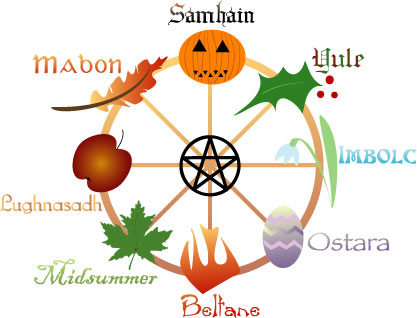

Days of Celebration

Our special days of celebration are divided into Sabbats and Esbats. The Sabbats are Solar holidays and Esbats corresponds to Lunar phases. The most important Esbats are the Full and New Moon, and we won't go into detail about them here. But here is an outline of the Sabbats, of which the cross-quarter festivals are most important. (The ones that are not solstices or equinoxes)

Samhain
This is the pagan celebration that has been modernised into Halloween. Samhain, pronounced Sow-en, is celebrated on 31st October and is a special celebration because many non pagan friends may want to join in the fun since the holiday is not so new to them. As the name All saints eve implies, it is a celebration of the dead. Samhain is the eve of the Thin Veil when the boarders to the kingdom of the dead - the summer land or Tir na nog - are especially thin. Therefore it is a good night for divination as well as remembering those who have gone before us, and our ancestors. The reason why I present this holiday first is because it is the pagan New Year.
Yule
Yule, or Midwinter, occurs on the winter solstice, which means that it is the shortest day of the year. It is a celebration that from this day onward, we will go towards warmer times. A time of rebirth, when we celebrate the birth of the Child, the reborn god. Because it is celebrated on the eve of the solstice, the date may vary from year to year, but it is around the 21st Dec.
Imbolc
Here is another pagan holiday that the Christians adopted. The Celtic Goddess Brighid became Saint Brigit and her holiday became known as the Christian Candlemas on February 1st. To us she is the Goddess of poetry, smithcraft and healing and her symbol is the sacred fire. She had a female priesthood at Kildare in Ireland who kept a sacred flame burning in her honour at all times. Today we celebrate that as the new light and the coming of spring. The name Imbolc originates from the tradition that it is around this time that the ewes begin to lactate.
Ostara
At Ostara, the name from which Easter originates, the day and night are of equal length; it is the Spring equinox. A celebration of the balance between light and dark. New beginnings. Occurs around 21st of March. A pagan origin of Easter, which gave lasting traditions such as Easter-eggs and the familiar bunny. Alban Eiler is the Druids name for the spring equinox.
Beltane
This is the last of the spring holidays, and is a celebration of sexuality and fertility. Traditionally a huge bonfire is lit, over which people jump, or dance around. In the past, herds of cattle were driven between two bonfires for blessings. As the opposite of Samhain, it is a celebration of life. The time of the Horned Good and the Lady of the Greenwood as the symbolic marriage of the Lord and Lady is the focus of this festival. May 1st.
Midsummer
The longest day of the year is celebrated most commonly by dancing and playing into the shortest night of the year. At the summer solstice, everything is in its prime, and the gifts of the God and Goddess are honoured. The Sun king is at the peak of his power. Celebration of success. Good time to celebrate outside and let yourself be in tune with nature. Approximately June 22.
Lughnasadh
A harvest festival where the Celtic God Lugh is honoured. A time of giving thanks for the harvest. Also a celebration of the self-sacrifice of the Goddess Tailtiu to give abundance and yield to the land. Celebrated on August 1. Also called Lunasa or Lammas.
Mabon
Named after a Celtic God, the son of the Goddess. This is the fall equinox when the day and night are once again of equal length and the year turns once more towards the darker half. A balance between light and dark. A time of rest after the work with the harvest. Occurs around September 21. Alban Elved is the Druids name for the autumn equinox.

The webmistress would be happy to hear of your queries or comments.
![[sitemap]](gifs/sitemap.jpg)
|






![[sitemap]](gifs/sitemap.jpg)